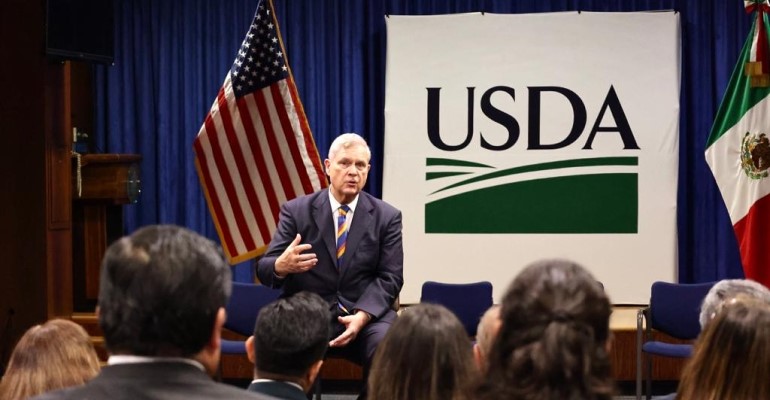
Despite agricultural supply constraints stemming from the ongoing crisis in Ukraine, Secretary of Agriculture Tom Vilsack again doubled down on the notion that USDA will not interfere with the current market indicators that allow farmers to make decisions about what acres to enroll in the Conservation Security Program.
In a letter dated March 23, agricultural groups including the National Grain and Feed Association and American Farm Bureau Federation urged USDA to provide flexibility to producers to plant crops on prime farmland enrolled in CRP without penalty, whether on an emergency basis or through an early-out of their current CRP contracts.
“You don't need to force farmers to take land out of CRP,” Vilsack told reporters in a call on April 5. “You don't need to force 'em. I don't know why anybody would want me to.”
Vilsack explains of the 4 million acres that are expiring this year, he says 52-56% of those acres (1.8 million acres) did decide to renew their contracts. “We got a few new contracts, but nowhere near the number of acres that did not re-up,” Vilsack shares.
Related: Should CRP acres be utilized in wake of Ukrainian War?
The market responds to signals and farmers make the best decision they can for their own operation based on those market signals.
“Frankly, farmers have the ability, even those who re-up have the ability, at any time to leave the CRP program,” Vilsack says of the program regulations which allow farmers to pay a penalty of the previous CRP payments made on the contract. “So, there’s no reason to mandate or force or pressure farmers to do this because they’re going to do it when it’s in their best interest, and they are doing it.”
Vilsack adds, “Folks are asking us to force farmers to do something that farmers have the capacity do themselves, and we at USDA trust the farmer to make the right decision for themselves. And some farmers decided that CRP is what they need.”
NGFA says the latest National Resources Inventory shows that out of the 15.9 million acres in general CRP sign-up, 4.1 million of these (or 26%) were “prime farmland.” Prime farmland is defined as “land that has the best combination of physical and chemical characteristics for producing food, feed, forage, fiber, and oilseed crops that is also available for these uses.” The percentage of prime farmland acres in CRP has remained relatively consistent since CRP was created, NGFA says.
However, in a letter response to NGFA, Vilsack shares that the most recent NRI released in 2020 shows that only 1.3% of prime farmland is enrolled in CRP; moreover, the prime farmland acreage in CRP has been decreasing since 1992.
“There are more than 100 million acres of prime farmland–or more than 25 times the amount in CRP–in non-cropland including pastureland, rangeland and forestland. CRP acres are disproportionately non-prime cropland, with more than 75% of acres from less productive, non-prime farmland. In contrast, more than 55% of all cropland is prime farmland,” Vilsack says.
Vilsack also defends that a considerable portion of currently enrolled CRP acres are in areas experiencing significant levels of drought. “Production on those acres would be marginal at best, and there is no realistic way to convert all CRP acres into cropland in 2022,” Vilsack writes. “Even under non-drought scenarios, we know from historic data that acres coming out of CRP have significant ‘slippage,’ meaning that one acre coming out of CRP does not transfer into an acre of crop production, but closer to half that.”
Market driving CRP enrollment
Vilsack writes, “We must also remember that market conditions have always driven CRP enrollment, and farmers are extremely effective at making decisions to maximize profitability, and in turn, production.”
With almost 4 million acres of CRP expiring this year, many landowners will have the option to bring some land back into production, and in many cases, they may choose to re-enroll buffers and sensitive portions of the land while returning other areas to production.
“While our Farm Service Agency field offices are still finishing processing the General CRP offers, our data reflect the reality that, with higher commodity prices, producers are not re-enrolling all of these acres in CRP,” Vilsack says. “Instead, high prices for this year’s crops will motivate producers to plant more acres of wheat, soybeans and corn, with the main limiting factors being weather and soil moisture conditions.”
Vilsack says USDA is keeping in mind the flexibilities that can be exercised under CRP in the form of emergency haying and grazing, with protections in place to prevent permanent damage to the land or the cover should the situation demand such flexibilities be used. Already, at times of limited hay availability due to drought or other natural disasters, USDA allows emergency haying and grazing on certain CRP lands at certain times.
Vilsack says USDA will ensure that producers with land coming out of CRP are presented with all available options, including transitioning some of those acres to other working lands conservation programs. “There is no need to step in and adjust the program when producers themselves are making decisions based on market conditions and environmental realities,” Vilsack says.
NGFA says it is interested in working with USDA on the Transition Incentive Program, which helps transition expiring CRP acres to a beginning or socially disadvantaged farmer to return land to production using sustainable grazing or crop purchases.
About the Author(s)
You May Also Like






